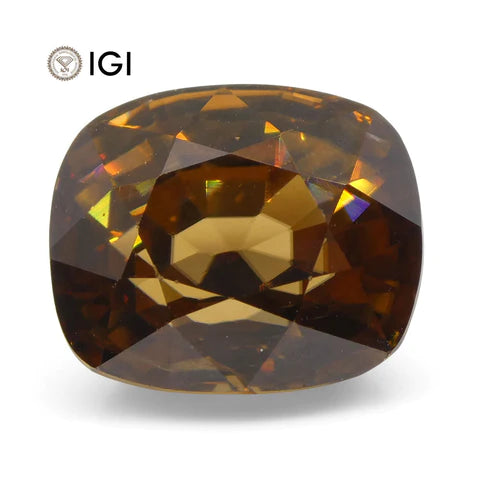
The Zing of Zircon, Part 1: A Jaunty Jewel
Share
|
Species |
|
|
Chemical Formula |
ZrSiO4 |
|
Mohs Hardness |
6 - 7.5 |
|
Cleavage |
Indistinct |
|
Lustre |
Vitreous to Adamantine |
|
Refractive Index |
1.78 - 2.01 |
|
Birefringence |
0.000 - 0.059 |
|
Dispersion |
0.039 |
|
Pleochroism |
Weak to Distinct |
|
Specific Gravity |
3.93 - 4.80 |
The name “zircon” will sound familiar to many people, but this splendid natural gemstone receives significantly less attention than it deserves despite the fact that zircon gems are an important part of the contemporary jewellery trade. The mineral form of zirconium silicate (ZrSiO4), this somewhat rare gemstone has been sought after by human beings for thousands of years, and it continues to add flare to the jewellery designs of today which is not easily rivalled by other coloured gems. The English name for zircon comes from the German word “zirkon”, which is thought to be derived from the arabic word “zarkun” meaning “vermillion”, although some academics believe that the Persian word “zargon” meaning “golden” is the source of zircon’s name; zircon gemstones may be golden or vermillion among other colours, so both “zarkun” and “zargon” are equally plausible roots of the word “zirkon”. With its diverse range of hues and variable optic character, there exists a zircon gemstone for nearly every gem lover and jewellery enthusiast.
A faceted blue zircon gemstone from Cambodia; Image: Skyjems
Some of zircon’s most desirable properties are its high refractive index, high dispersion, and strong lustre. Zircon typically refracts, i.e. “bends”, light much more than the majority of well known gem varieties, and zircon’s dispersion value of 0.039 is significantly higher than most other coloured gemstones, even approaching diamond’s dispersion value of 0.044. These characteristics, in combination with its potential to show an adamantine or “diamond-like” lustre, make zircon an aesthetic rival to diamond. The similarities between diamond and zircon gems are particularly apparent when comparing stones that are completely colourless, and this resemblance is even more obvious if the stones being compared have been given a round brilliant cut. Although very similar looking to the naked eye, zircon gemstones can often still be separated from diamonds due to their high birefringence, which causes a double refraction of light passing through them, giving the inside of gems a doubled or blurry appearance. The birefringence of zircon is highly variable though and not all zircon gems display readily visible double refraction, but diamonds will never exhibit this same phenomenon. Zircon and diamond can also be easily distinguished from one another by differences in their hardness; the hardness of zircon is markedly lower than that of diamond, ranging from 6 to 7.5 on the Mohs hardness scale as opposed to 10. In addition to its lower hardness, zircon is also quite brittle in tenacity.
A faceted brown-orange zircon gemstone; Image: Skygems
The higher end of zircon’s hardness may be more suitable for certain jewellery pieces, but the potential for zircon gems to rank as low as 6 in hardness in addition to zircon brittle nature means jewellers must be mindful when creating bespoke jewellery designs that feature zircon gemstones. These characteristics of zircon would preclude some zircon gemstones from being used in custom engagement rings or other everyday ring designs, as zircon gems of lower hardness would scratch more easily, and their facet junctions would be prone to chipping due to zircon brittleness. Similarly, zircon gems set into everyday bracelets are at greater risk of being damaged. zircon gemstones are best suited for use in rings and bracelets worn only occasionally, but zircon can be worn every day almost carefree in earrings and/or pendants. The durability of zircon would make the use of ultrasonic cleaners unadvisable for jewellery featuring zircon gems, and it is recommended that bespoke ring and bracelet settings meant for zircon be designed with a protective structure to shield stones from direct impacts and/or abrasions.
A faceted dark red zircon gemstone; Image: Skyjems
A curious product of nature, zircon gems vary in more ways than just their colour. In the next part of this series, learn about the ways in which zircon gems may differ from one another in colour and character.
© Yaĝé Enigmus









